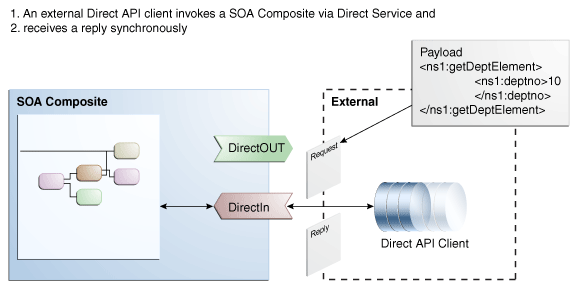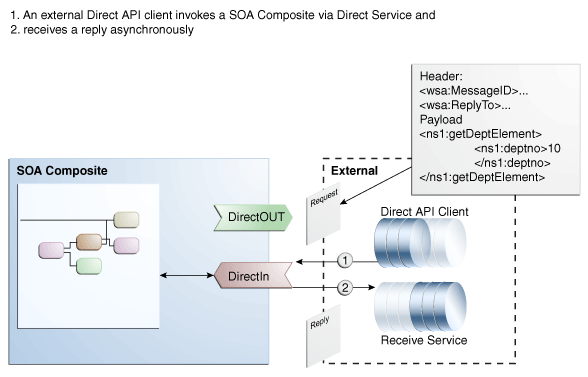Direct Reference Binding Component
The direct reference binding component requires the following information to connect to a user-provided SOA invoker:
-
Properties:
A set of properties that defines the
DirectConnectionfor the end service (seeoracle.soa.management.facade.Locator). -
ConnectionFactoryclass name (seeoracle.soa.management.facade.Locator).The
ConnectionFactoryclass must implement theoracle.soa.api.invocation.DirectConnectFactoryinterface.If the
ConnectionFactoryclass name is not specified, the defaultoracle.soa.api.JNDIDirectConnectionFactoryis used. To use the default connection factory, you must supply the lookup name for the EJB. -
Address used by the external service:
This address value is not processed by the binding component, but is passed on to the service bean during invocation.
-
addressingVersion(optional):The default addressing version used is
2005/08. -
useSSLForCallback:Use a secure socket layer (SSL) for the callback JNDI connection. If this flag is set to
true, then the WS-AddressingreplyToheader instructs the service to call back at an SSL JNDI port.
A sample configuration is shown in the following example:
<reference name="HelloReference" ui:wsdlLocation="HelloService.wsdl"> <interface.wsdl interface="http://hello.demo.oracle/#wsdl.interface(HelloInterface)"/> <binding.direct connection-factory="oracle.soa.api.JNDIDirectConnectionFactory" addressingVersion="http://www.w3.org/2005/08/addressing" address="soadirect://syncOut" useSSLForCallback="false"> <property name="oracle.soa.api.invocation.direct.bean">MyDirectTestServiceBean#directEjb.Tes tInvoker</property> <property name="java.naming.factory.initial">weblogic.jndi.WLInitialContextFactory</property > <property name="java.naming.provider.url">t3://@host:@port</property> </binding.direct> </reference>
The direct binding components support both synchronous and asynchronous invocation patterns. Figure 39-1 describes a sample synchronous invocation pattern and Figure 39-2 describes a sample asynchronous invocation pattern.
Figure 39-1 Sample Synchronous Invocation Patterns

Description of "Figure 39-1 Sample Synchronous Invocation Patterns"
Figure 39-2 Sample Asynchronous Invocation Pattern

Description of "Figure 39-2 Sample Asynchronous Invocation Pattern"